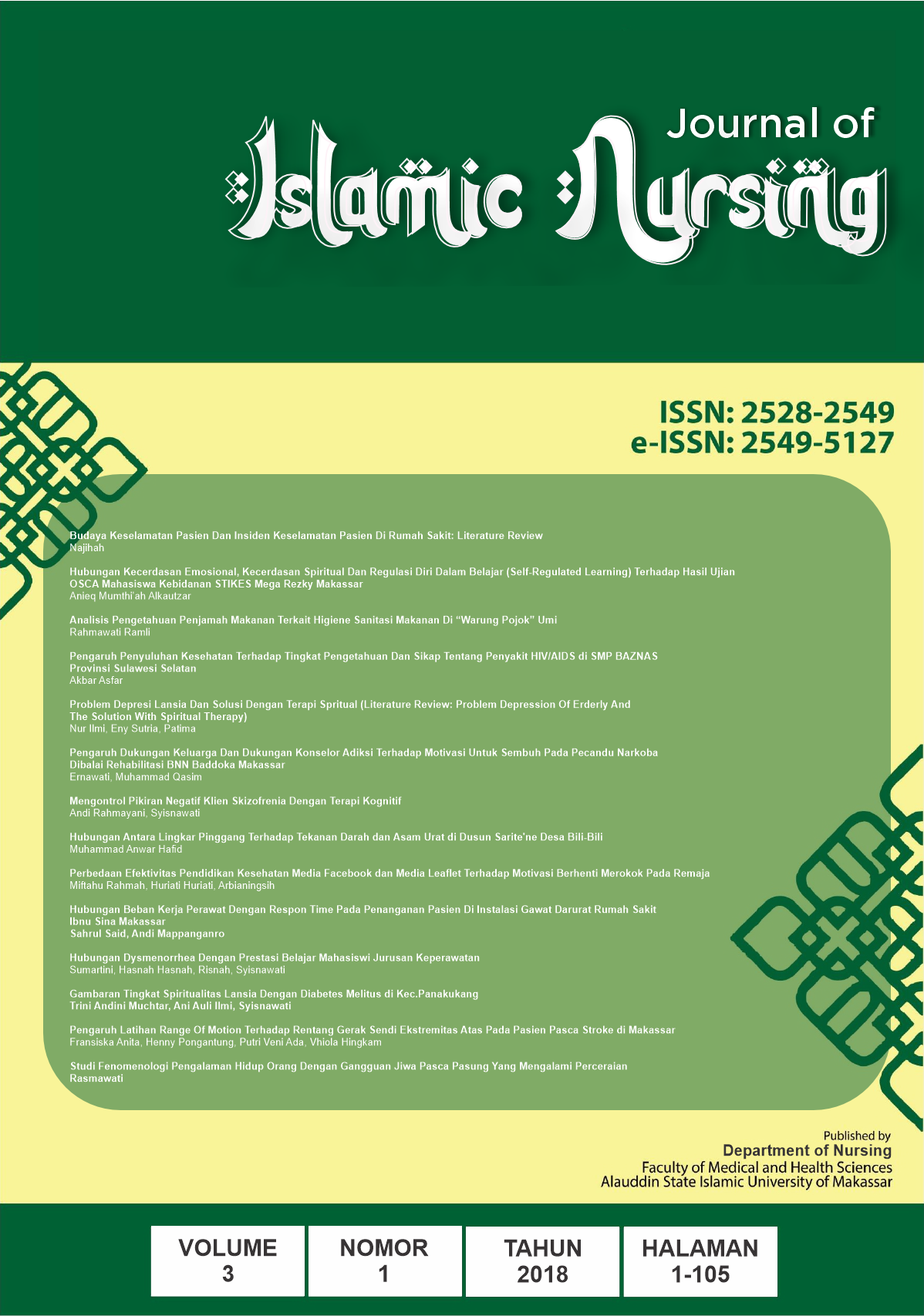BUDAYA KESELAMATAN PASIEN DAN INSIDEN KESELAMATAN PASIEN DI RUMAH SAKIT: LITERATURE REVIEW
Abstract
Patient safety in health care has gained much attention since the Institute of Medicine (IOM) in 2000 published a report entitled "To Err is Human: Building a Safer Health System" which points to the death rate from KTD in hospitalized patients across America totaling 44,000- 98,000 people per year. By using a lower estimate, more people die from medical errors in a year than road accidents, breast cancer, or AIDS. Therefore, if the hospital wants to reduce the incidence of patient safety incidents then the hospital should implement a patient safety culture. The purpose of this paper is to know the application of patient safety culture related to Evidence Based patient evidence incidents. In the literature search process, used several databases such as Pubmed, PMC, NCBI, PXJ, NJEM and BMJ. Keywords included are keywords relevant to the material, namely "Patient Safety Culture", "Patient Safety Incident" and "Reporting Patient Safety Incident". From various literature findings, 12 research articles were combined and considered relevant to the topic. From various research articles it is concluded that the patient safety culture is closely related to the incidence of patient safety incidents. As the patient's safety culture increases, the incidence of patient safety incidents can be minimized. One effort that can be made to improve the application of a patient safety culture to minimize patient safety incidents is to report patient incident safety, either KNC, KPC, KTC let alone KTD
Downloads
References
Brown, D. S., & Wolosin, R. (2013). Safety Culture Relationships with Hospital Nursing Sensitive Metrics. Journal for Healthcare Quality, 61-74.
Cherry, B., & Jacob, S. R. (2014). Contemporary Nursing : Issue, Trend, & Management 6th Edition. United States: Elselvier.
Davies, E. C., Green, C. F., Mottram, D. R., & Pirmohamed, M. (2010). Interpreting adverse drug reaction (ADR) reports as hospital patient safety incidents. British Journal of Clinical Pharmacology, 102-108.
Depkes RI. (2008). Panduan Nasional Keselamatan Pasien Rumah Sakit (Patient Safety): Utamakan Keselamatan Pasien. Jakarta: Depkes RI.
Hawkins, C. T., & Flynn, L. (2015). Patient Safety Culture and Nurse-Reported Adverse Events in Outpatient Hemodialysis Units. Research and Theory for Nursing Practice: An International Journal, 53-65.
Hewitt, T. A., & Chreim, S. (2015). Fix and forget or fix and report: a qualitative study of tensions at the front line of incident reporting. BMJ Quality & Safety Online, 1-8.
Kagan, I., & Barnoy, S. (2013). Organizational Safety Culture and Medical Error Reporting by Israel Nurses. Journal of Nursing Scholarship, 273-280.
Kemenkes RI. (2011). Permenkes RI No.1691/Menkes/VIII/2011 tentang Keselamatan Pasien Rumah Sakit. Retrieved 11 23, 2015, from http://202.70.136.86/bprs/uploads/pdffiles/21%20PMK%20No.%201691%20ttg%20Keselamatan%20Pasien%20Rumah%20Sakit.pdf
Kim, I. S., Park, M. J., Park, M. Y., Yoo, H., & Choi, J. (2013). Factors Affecting the Perception of Importance and Practice of Patient Safety Management among Hospital Employees in Korea. Asian Nursing Research, 26-32.
KKP RS. (2011). Laporan Insiden Keselamatan Pasien. Jakarta: KKP RS.
Kousgaard, M. B., Joensen, A. S., & Thorsen, T. (2012). Reasons for not reporting patient safety incidents in general practice:A qualitative study. Scandinavian Journal of Primary Health Care, 199-205.
Kroening, H. L., Kerr, B., Bruce, J., & Yardley, I. (2015). Patient complaints as predictors of patient safety. Patient Experience Journal, 94-101.
Morag, I., Gopher, D., Spillinger, A., & Shpak, Y. A. (2012). Human Factors–Focused Reporting System for Improving Care Quality and Safety in Hospital Wards. Human Factors, 195-213.
Permadhi, A. (2013). Hubungan Budaya Keselamatan Pasien Dalam Pelayanan Keperawatan dan Insiden Keselamatan Pasien di Instalasi Rawat Inap RSD dr. Soebandi Jember. Retrieved 11 23, 2015, from http://repository.unej.ac.id/bitstream/handle/123456789/56073/AGUNG%20PERMADHI_1.pdf?sequence=1
Urbach, D. R., Govindarajan, A., Saskin, R., Wilton, A. S., & Baxter, N. N. (2014). Introduction of Surgical Safety Checklists in Ontario Canada. The New England Journal of Medicine, 1029-1038.
Wang, X., Liu, K., You, L. M., Xiang, J. G., Hu, H. G., Zhang, L. F., et al. (2014). The relationship between patient safety culture and adverse events: a questionnaire survey. International Journal of Nursing Study, 1114-1122.
Xuanyue, M., Yanli, N., Hao, C., Pengli, J., & Mingming, Z. (2013). Literature review regarding patient safety culture. Journal of Evidence-Based Medicine, 43-49
Yilmaz, Z., & Goris, S. (2015). Determination of the patient safety culture among nurses working at intensive care units. Pakistan Journal Of Medical Science, 597-601.


